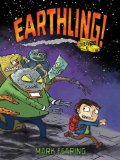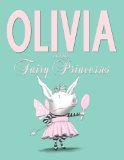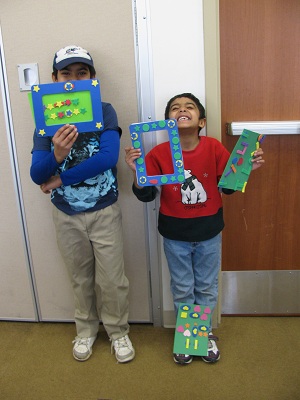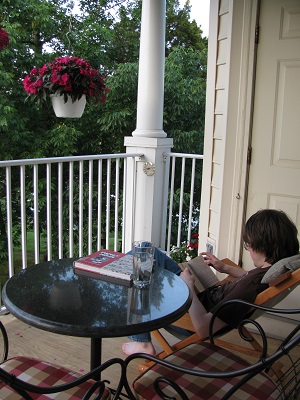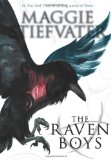 The Raven Boys
The Raven Boys
The Raven Cycle, Book 1
by Maggie Stiefvater
Scholastic Press, 2012. 409 pages.
I adored The Scorpio Races, by Maggie Stiefvater, so I picked up this book eagerly. It’s not quite as much my cup of tea, but I still am eagerly looking forward to the next book.
The premise is powerful. Here’s the first sentence:
Blue Sargent had forgotten how many times she’d been told that she would kill her true love.
The narrator goes on to explain that Blue’s mother and aunts are psychics. They tell people’s fortunes, always explaining that the predictions are accurate but not specific.
But this was not what Blue was told. Again and again, she had her fingers spread wide, her palm examined, her cards plucked from velvet-edged decks and spread across the fuzz of a family friend’s living room carpet. Thumbs were pressed to the mystical, invisible third eye that was said to lie between everyone’s eyebrows. Runes were cast and dreams interpreted, tea leaves scrutinized and seances conducted.
All the women came to the same conclusion, blunt and inexplicably specific. What they all agreed on, in many different clairvoyant languages, was this:
If Blue was to kiss her true love, he would die.
The Prologue ends with Blue meeting her mother’s half-sister, Neeve, a much more famous psychic.
“You’re Maura’s daughter,” Neeve said, and before Blue could answer, she added, “This is the year you’ll fall in love.”
That’s in the Prologue. In Chapter One, we find Blue in a small churchyard with Neeve on St. Mark’s Eve. Blue is not psychic, has never had visions. Blue’s presence, however, enhances the powers of psychics she is with. Her mother normally goes to the churchyard on St. Mark’s Eve to see the souls of those who will die in the coming year march past. She gets their names, and generally gives these people a warning.
But this year, Blue sees one of the souls. The first time she has ever done so. He’s wearing a sweater from Aglionby Academy, the rich kids’ school whose students wear a uniform with a raven emblem. He says his name is Gansey.
Neeve has an explanation for why this time Blue can see the dead-to-be:
“There are only two reasons a non-seer would see a spirit on St. Mark’s Eve, Blue. Either you’re his true love,” Neeve said, “or you killed him.”
So, that’s some mighty heavy foreshadowing. Blue does meet Gansey, and a group of his friends. Her mother warns her to stay away, which of course eggs her on. (Though I would think all these predictions might just do the trick.) We also spend time with Gansey and his group of friends, misfits in some ways. Ronan is angry, has a horrible past, and is in constant danger of being kicked out of Aglionby. Noah is very quiet and hardly ever speaks. Adam’s a kid on scholarship with an awful family background and sensitive about spending time with people rolling in wealth. He’s the one who seems to have a crush on Blue, and I found myself wanting her to return it.
Gansey is on a quest. He is looking for a dead Welsh king who promised to return, who promised a wish come true for whoever awakens him. Gansey has strong reason to believe the king’s body was hidden in the hills of West Virginia. One of the ley lines is what Blue knows as the corpse road, where she was on St. Mark’s Eve.
Why didn’t I warm more to the story? In the first place, I’ve got reservations about fortunetelling, having grown up in a conservative Christian home. Now, I realize that it makes a fine storytelling device, but this had an awful lot of occult practices. I know, I know, it’s a story, but that kept me a bit at a distance.
Now, the portrayal of the friendships is done wonderfully, and the way Blue gets to know the Raven Boys is realistic and fun. Each of their back stories is well-drawn and these characters are each interesting individuals. There’s a mystery, and a revelation about two-thirds of the way through the book that is positively brilliant.
But I wasn’t onboard with the romance. Everything up to the first chapter would lead you to believe she’s going to fall in love with Gansey, she’s going to kiss him, and he’s going to die. That’s not a spoiler, since those predictions alone would give you that impression. What’s more, there are further visions and predictions about her and Gansey.
So what can I say to not give it away? Well, I’m just not satisfied about how that’s going so far. My heart doesn’t believe in her falling in love with Gansey.
Though it is possible Maggie Stiefvater will win me over in the next volume. But the further time goes by, the more resistant I am to that romance.
As far as the mystery, friendships, and dramatic climax? Excellent! So I will definitely keep reading The Raven Cycle. If the characters didn’t exactly warm my heart, I still want to find out what happens to them. And I want to know if Blue can evade what seems to be her destiny.
maggiestiefvater.com
scholastic.com
Buy from Amazon.com
Find this review on Sonderbooks at: www.sonderbooks.com/Teens/raven_boys.html
Disclosure: I am an Amazon Affiliate, and will earn a small percentage if you order a book on Amazon after clicking through from my site.
Source: This review is based on an Advance Reader Copy I got at an ALA conference.
Disclaimer: I am a professional librarian, but I maintain my website and blogs on my own time. The views expressed are solely my own, and in no way represent the official views of my employer or of any committee or group of which I am part.
Please use the comments if you’ve read the book and want to discuss spoilers!
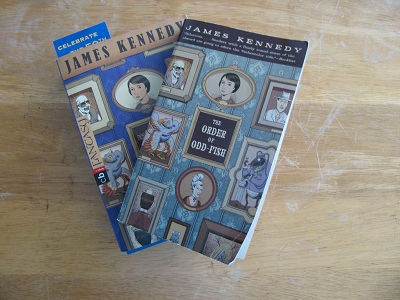 It’s back! Time again for Sonderling Sunday, that time of the week when I play with language by looking at the German translation of children’s books.
It’s back! Time again for Sonderling Sunday, that time of the week when I play with language by looking at the German translation of children’s books.
